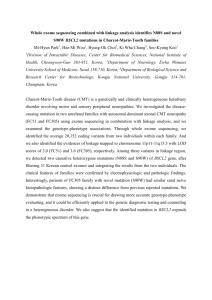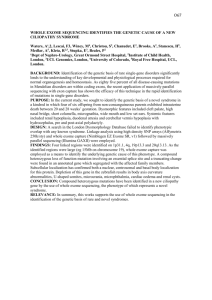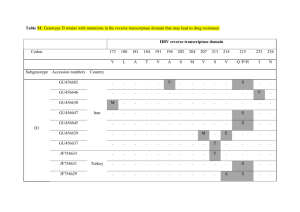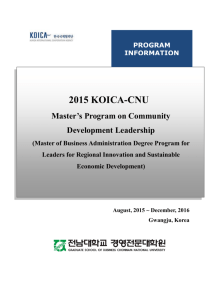김난영 - 한국유전체학회
advertisement
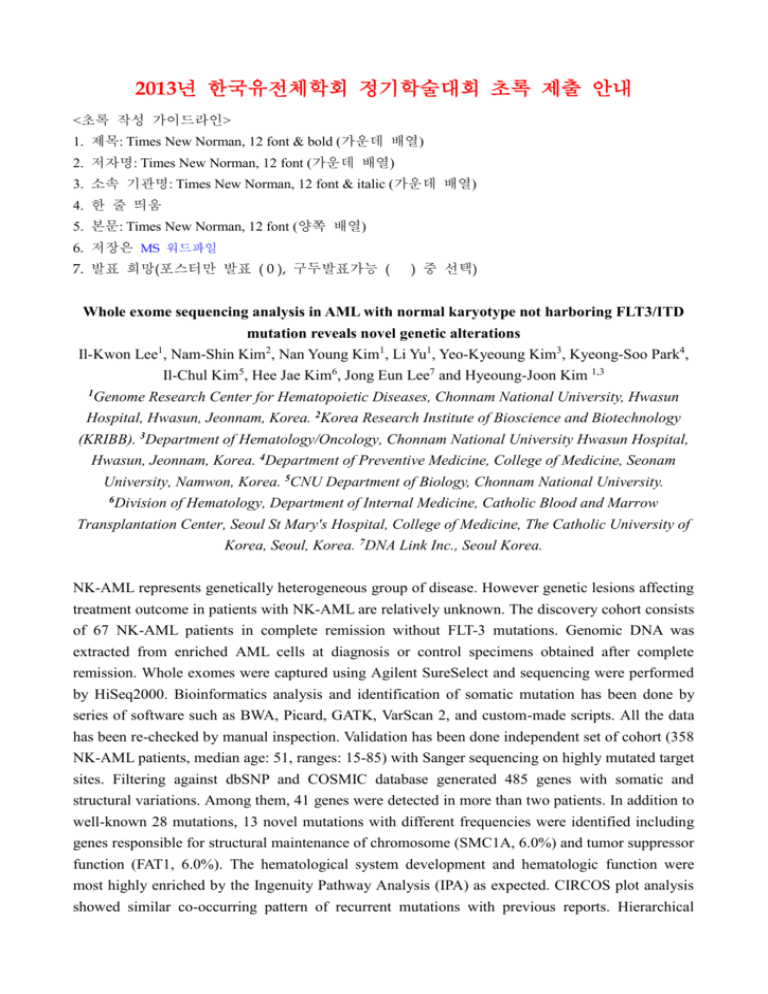
2013년 한국유전체학회 정기학술대회 초록 제출 안내 <초록 작성 가이드라인> 1. 제목: Times New Norman, 12 font & bold (가운데 배열) 2. 저자명: Times New Norman, 12 font (가운데 배열) 3. 소속 기관명: Times New Norman, 12 font & italic (가운데 배열) 4. 한 줄 띄움 5. 본문: Times New Norman, 12 font (양쪽 배열) 6. 저장은 MS 워드파일 7. 발표 희망(포스터만 발표 ( 0 ), 구두발표가능 ( ) 중 선택) Whole exome sequencing analysis in AML with normal karyotype not harboring FLT3/ITD mutation reveals novel genetic alterations 1 Il-Kwon Lee , Nam-Shin Kim2, Nan Young Kim1, Li Yu1, Yeo-Kyeoung Kim3, Kyeong-Soo Park4, Il-Chul Kim5, Hee Jae Kim6, Jong Eun Lee7 and Hyeoung-Joon Kim 1,3 1Genome Research Center for Hematopoietic Diseases, Chonnam National University, Hwasun Hospital, Hwasun, Jeonnam, Korea. 2Korea Research Institute of Bioscience and Biotechnology (KRIBB). 3Department of Hematology/Oncology, Chonnam National University Hwasun Hospital, Hwasun, Jeonnam, Korea. 4Department of Preventive Medicine, College of Medicine, Seonam University, Namwon, Korea. 5CNU Department of Biology, Chonnam National University. 6Division of Hematology, Department of Internal Medicine, Catholic Blood and Marrow Transplantation Center, Seoul St Mary's Hospital, College of Medicine, The Catholic University of Korea, Seoul, Korea. 7DNA Link Inc., Seoul Korea. NK-AML represents genetically heterogeneous group of disease. However genetic lesions affecting treatment outcome in patients with NK-AML are relatively unknown. The discovery cohort consists of 67 NK-AML patients in complete remission without FLT-3 mutations. Genomic DNA was extracted from enriched AML cells at diagnosis or control specimens obtained after complete remission. Whole exomes were captured using Agilent SureSelect and sequencing were performed by HiSeq2000. Bioinformatics analysis and identification of somatic mutation has been done by series of software such as BWA, Picard, GATK, VarScan 2, and custom-made scripts. All the data has been re-checked by manual inspection. Validation has been done independent set of cohort (358 NK-AML patients, median age: 51, ranges: 15-85) with Sanger sequencing on highly mutated target sites. Filtering against dbSNP and COSMIC database generated 485 genes with somatic and structural variations. Among them, 41 genes were detected in more than two patients. In addition to well-known 28 mutations, 13 novel mutations with different frequencies were identified including genes responsible for structural maintenance of chromosome (SMC1A, 6.0%) and tumor suppressor function (FAT1, 6.0%). The hematological system development and hematologic function were most highly enriched by the Ingenuity Pathway Analysis (IPA) as expected. CIRCOS plot analysis showed similar co-occurring pattern of recurrent mutations with previous reports. Hierarchical clustering analysis divided into four different groups according to the number of harboring mutations. In network analysis four distinct subgroups were observed ranging 21 to 3 gene network. Using whole exome sequencing approach, a catalog of recurrent mutations was successfully defined in the patients with NK-AML without FLT3/ITD mutation. This candidate list of novel mutations should be tested further for therapeutic target and prognostic marker in the patients with NK-AML.
